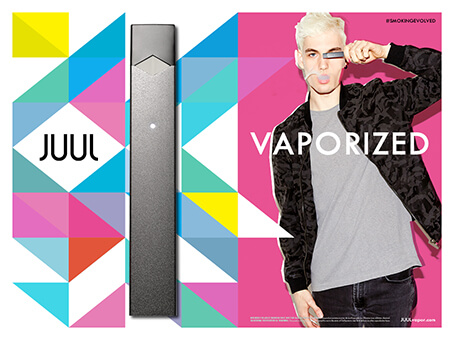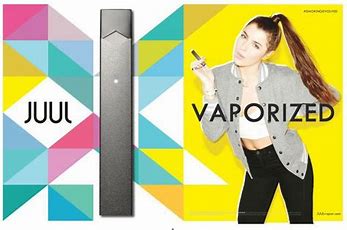JUUL: The New Epidemic Sweeping America's Youth

PARENTS PAY ATTENTION!
If you think your kid is not doing this, I can guarantee you they are. They are either Juuling or Phixing. This new epidemic is sweeping across campuses. Don't be caught off guard when someone whips it out. Do not be naive and defend anyone as it pertains to its unhealthy side effects.
Trends come and go at schools faster than you can say “conformity”; however, the latest trend is here at all college campuses and high school campuses across the United States. It's here to stay and will create a health care crisis in the future. The crisis has already began. This new craze is the Juul pen craze. Juul is the newest brand of e-cigarettes that some are hailing as the “iphone of electronic delivery systems (ENDS). This little device seems to be a handy sidekick for students from all walks of life. However, this trend may be more insidious than most; medical professionals and neuroscientists everywhere are delivering a cautionary warning about an otherwise exploding trend. Along with the highly addictive potential of the JUUL’s nicotine, there is extensive evidence that long-term nicotine exposure starting in one’s young adult years leads to psychiatric mood disorders as well as attention and memory deficits later in life.
Why is this so popular? Is it the new, compact look that makes them so much easier to hide than classic vape pens? Is it the higher nicotine concentration they offer to users? Or is it just a trend, something that will pass shortly? These are questions only a user could answer.
Smoking a Juul (pronounced “jewel”), a new type of vaporizer pen (e-cigarettes that vaporize flavored nicotine “juice”), has become the new epidemic. More than 95% of kids in schools and colleges are doing this. Everywhere you look someone is blowing the thin, nicotine rich smoke into their sleeve. The 95% is not an exaggerated number, it's the reality.

Phix shown in photo
Juul or Phix, both products come in numerous flavors. The nicotine content is five percent in Juul and PHIX. However, pods for the Juul only provide two hundred puffs, which is the equivalent of the amount of puffs that you'll get out of a typical pack of cigarettes.
The amount of nicotine in a cigarette varies by brand. On average, one pack of cigarettes contains 8 to 20 milligrams of nicotine and only 1 milligram is absorbed when smoked. Therefore one cigarette, on average, contains 1.2 milligrams of nicotine and the smoker will absorb about 0.1 milligram.
The nicotine content of the JUUL pods is always the same: 5% or 50 mg/ml. Now, this seems like a huge amount of nicotine – at least twice as much as most other e-cigs. This level of nicotine is creating a nationwide epidemic.
In speaking with students an addicts of Juul the conversation was heartbreaking. Kids are spending upwards of 30 dollars a week on “pods,” cartridges you attach to the Juul that contain the nicotine juice users fiend for. Juuls are highly addictive and bad for your health. Many diseases are linked to tobacco and nicotine, including cardiovascular disease, stroke, lung cancer, cancer of the kidney, cancer of the larynx and neck, mouth cancer and breast cancer. Not only that, but those who are being affected negatively by this trend are vulnerable young people who may not even realize what they’re getting themselves into.
Students are buying a Juul starter kit. It comes with a Juul, a charger and four pods. A pod is what the juice is in. They’re disposable, you use it once. The pods can be refilled. You can only buy a pack of four pods and it’s 16 dollars. One pod is the equivalent to the same amount of nicotine in one pack of cigarettes, but it’s cheaper. The Juul pods are so addictive, kids are vaping 4 to 5 pods a day. The Juul device looks like a flash drive.
The first time students do this they get a huge buzz from it. Once they start, it's so addictive that they cannot go one hour without ingesting it. The students refuse to go on school trips, due to the fact they cannot imagine not Juuling at whim. When they are unable to ingest it, they demonstrate behaviors of rudeness beyond the acceptable norms of society.


The kids are stealing from their parents to pay for the pods. Parents are completely unaware of what their kids are doing. They literally can push the smoke into their sleeve. You won't smell a thing. Everyone who is Juuling is an addict. If they say they are not, they are lying.
E-cigarettes aren’t quite as safe as they’ve been thought to be in the past. Recent studies show that e-cigarettes reduce your ability to cough and may expose your body to potentially harmful chemicals. On top of that, different e-cigarette flavors may have different effects. What’s worst? Even though they’ve been marketed to help people quit smoking, they don’t have that effect. The companies selling them, including Juul, know all of this, yet they continue to stalk the youth of America.
In terms of the respiratory effects of both the act of vaping and the carcinogenic nature of the chemicals found in JUUL products, the jury is still out. However, in terms of the long-term effects of nicotine, researchers have some ideas.
The old myth that the brain cells you are born with are the only ones you ever get has largely been disproven by evidence from current cutting edge neuroscience research. Your brain is very similar to a piece of clay in that it is continuously being molded by your life experiences, constantly changing and creating new connections. Then, around age 25, your “clay” brain becomes ceramic, and largely stays the same way throughout the rest of your adult life minus some special exceptions. Thus, the decisions and experiences you are choosing to expose yourself to right now in college are going to directly affect the way your brain functions for the rest of your lives. Following this, the impact of nicotine on your developing brain is a phenomena that is extremely pertinent in the research community.

Nicotine is a stimulant, meaning that it increases activity in the brain. It does this by acting as a key, “unlocking” receptors on neurons that then in turn cause chemical messengers to be released in your brain. Nicotine fits in many different locks, resulting in the diverse sensations you feel when using either a traditional cigarette or an electronic alternative like a JUUL. It can activate dopamine, resulting in the pleasurable feeling you seek out at parties, or acetylcholine, resulting in the memory boost that people use JUULs for when studying in the library. If you’re thinking about how awesome nicotine sounds right now and are about ready to go out and invest in a JUUL of your own, you are not alone; these short-term benefits are largely the reason why nicotine is so well-received among young adults, as we are especially sensitive to the advantageous results of nicotine.
Nicotine joins drugs like heroin and crack-cocaine in its addictive potential:
Since nicotine causes dopamine, the pleasure chemical, to be released, it places nicotine in the category of highly addictive drugs that take advantage of the human pleasure pathway in the brain. For reference of the severity of nicotine’s addictive potential, other drugs like heroin and crack-cocaine are nicotine’s counterparts on this list of highly addictive substances. The pleasurable nature of nicotine causes the user to continue to administer the drug, which eventually elicits an effect that sensitizes the individual to the drug. This means that the individual needs to take more and more of the drug to reach the same effect it had as it did in their very first hit of it. In addition, the individual’s natural dopamine receptors stop reacting to the body’s normal every day release of nicotine, meaning they have to use the drug to reach the normal level of dopamine release that they had previous to being exposed to the nicotine. This creates a vicious cycle in which an individual is constantly chasing that high, resulting in a physiological addiction over which a person has very little control. Sure the person can abstain from nicotine, but they will go through severe withdrawal symptoms that are extremely uncomfortable to tolerate and interfere with everyday life such as irritability, anxiety, difficulty concentrating, depression, and insomnia. Before you write off addiction as something that only happens to weak low-lives, know that addiction doesn't discriminate by age, sex, socioeconomic status, or moral standings; addiction can and does happen to everyone.
Nicotine has been suggested to cause depression and other mood disorders in long term users who begin taking the drug during adolescence:

Since Nicotine is a stimulant, it is known for causing a short term high that makes the user feel good. However, as mentioned above, has the body becomes used to nicotine, less and less dopamine is being stimulated to be released, meaning the individual is experiencing chronic lower levels of pleasure. This is suggested to be the reason why that mood disorders like depression are often comorbid with long term drug abuse such as in the case of nicotine addiction. In particular, the adolescents seem to be the most at risk for developing depression in conjunction with long-term nicotine use. In studies that administer nicotine to rats, rats who received nicotine during adolescence were far more likely to display depression-like symptoms in conjunction with long-term nicotine use, as opposed to rats who start receiving nicotine in their adulthood after their brains had finished developing. The replication of this evidence from a variety of different researchers is highly suggestive that long-term nicotine use before the brain finishes developing can put nicotine users at risk for the development of depression and other mood disorders later in life.
Long-term nicotine use has resulted in observable deficits in memory, especially working memory, and attention when the individual abstains from nicotine:
Some students are using Juul as a study aid. Short-term administration of nicotine has been observed to produce acetylcholine, a chemical that is vital for memory retrieval and consolidation. This is why you may look around the library and see your fellow college students using JUUL pens while studying. However, in the long-run nicotine seems to have the opposite effect: long-term use of nicotine starting in adolescence has been linked with deficits in working memory and attention. Although ex-smokers are somewhat able to regain some of these abilities by long-term nicotine abstaining, there is evidence their skill levels in memory and attention areas never fully reach the baseline levels of performance before ever being exposed to nicotine. Thus, by relying on JUULs for an extra boost while studying, you could be doing more long-term harm than good in the areas of memory and attention, even after you quit nicotine administration.
In addition to the health risks mentioned above, there has also been evidence of nicotine priming an individual for future drug abuse such as in the case of opioids and alcohol, as well as evidence that e-cigarettes such as JUULs can serve as “gateways” to the use of traditional cigarettes. Taken altogether, this evidence dealing with the possible long-term health implications of e-cigarettes such as JUULs makes it no surprise that experts warn against the unknowns of this new technology and that companies like PAX are hesitant to claim the “healthiness” of JUULs and other alternatives to traditional cigarettes.

According to the National Youth Tobacco Survey, more than over 18 million middle school and high school students reported seeing e-cigarette ads. The majority of youth were exposed to these ads in retail stores, followed by the Internet, movies, television, newspapers and magazines.
The marketing efforts have had dangerous consequences. The CDC has found that the number of youth using e-cigarettes radically increased, following the rapid increase in advertising efforts. E-cigarette use has serious consequences on a young person’s health. E-cigarettes contain addictive nicotine, cancer-causing chemicals such as formaldehyde, and the flavoring in e-cigarettes have been found to cause a disease known as “popcorn lung.”
Manufacturers maintain that they only market their products to adults, but that simply isn’t the case. These manufacturers are killing our youth. Placing them in line for lung transplants. They are selling their liquid nicotine in kid-friendly flavors such as bubblegum, mango and cotton candy. Even more alarmingly, e-cigarette companies were adopting widely recognized and trusted kid-focused brands such as Cap’n Crunch cereal and Winnie-the-Pooh to market their products to children.
Senator Markey (D-MA) and eight additional senators asked the U.S. Federal Trade Commission to investigate liquid nicotine retailers for deceptive practices. Eight senators sent letters to 147 liquid nicotine retailers requesting that they cease their marketing efforts immediately. But companies like Juul have not stopped.
Young people can be influenced by sleek, modern design more than other demographics, and this is exactly why JUUL is focused on marketing to younger age groups.
Some students defend their JUUL usage by claiming they aren’t as unhealthy as real cigarettes. While JUULs omit tobacco and some carcinogens found in cigarettes, their nicotine content and tasty flavor create the same, real addiction.
The only cure for the damage Juul does to youth is a lung transplant. Popcorn lung is a slang name used for a condition called bronchiolitis obliterans (BO), or obliterative bronchiolitis. It’s caused when inhaled chemicals scar the smallest airways within the lungs (bronchioles) and reduce their capacity and efficiency. There is no cure for BO except a lung transplant.
E-cigarettes are not regulated in the United States and can therefore be legally sold and used by minors. They aerosolize nicotine and other flavorings, and can be used to deliver other drugs of abuse. Ingestion of nicotine in large amounts often leads to nausea and vomiting, thereby limiting toxicity. Electronic cigarettes immediately impairs lung function, lasting for less than 30 minutes after smoking.
Additionally, JUULs contain the chemical propylene glycol, also found in antifreeze. Propylene glycol is also an approved additive to food, but inhaling it exposes the user to a more potent and potentially dangerous dosage.
It’s true that e-cigarettes break down freebase nicotine into a salt of nicotine, but don’t assume this means there is not a large amount of nicotine in the JUUL. The JUUL is unlike any other e-cigarette on the market. E-cigarettes that have come before JUUL usually only contain about 16 mg of nicotine per ml of e-liquid. JUUL tops the game by delivering a whopping 50 mg of nicotine. Not only that, but JUUL is one of the only brands of e-cigarettes that will give users a spike in their blood nicotine levels.
JUUL’s combination of chemicals cause addiction and can lead to severe diseases like bronchitis, heart disease and cancer. Not only that, but those in the presence of a user can get the same, detrimental side effects — especially young children. If that’s not convincing enough, consider this: Smoking one Juul pod is equal to smoking an entire pack of cigarettes.
Don’t be fooled by the 21st-century design or fall under the impression that they’ll do no harm — JUULs are very bad for you, just like cigarettes. While you might think you’re keeping things under control with JUUL, the addiction can become strong enough to lead you to search for something stronger, such as real cigarettes.
Looking “cool,” playing with a new gadget, fitting in with the crowd or getting a temporary high is not worth the money, addiction or disease. And remember: Cigarettes were marketed the same way before everyone knew they could kill you.
I hope this article saves your kids life.














